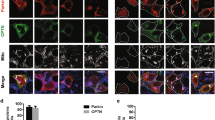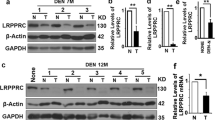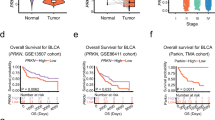Abstract
The parkin was first identified as a gene implicated in autosomal recessive juvenile Parkinsonism. Deregulation of the parkin gene, however, has been observed in various human cancers, suggesting that the parkin gene may be important in tumorigenesis. To gain insight into the physiologic role of parkin, we generated parkin−/− mice lacking exon 3 of the parkin gene. We demonstrated here that parkin−/− mice had enhanced hepatocyte proliferation and developed macroscopic hepatic tumors with the characteristics of hepatocellular carcinoma. Microarray analyses revealed that parkin deficiency caused the alteration of gene expression profiles in the liver. Among them, endogenous follistatin is commonly upregulated in both nontumorous and tumorous liver tissues of parkin-deficient mice. Parkin deficiency resulted in suppression of caspase activation and rendered hepatocytes resistant to apoptosis in a follistatin-dependent manner. These results suggested that parkin deficiency caused enhanced hepatocyte proliferation and resistance to apoptosis, resulting in hepatic tumor development, partially through the upregulation of endogenous follistatin. The finding that parkin-deficient mice are susceptible to hepatocarcinogenesis provided the first evidence showing that parkin is indeed a tumor suppressor gene.
This is a preview of subscription content, access via your institution
Access options
Subscribe to this journal
Receive 50 print issues and online access
$259.00 per year
only $5.18 per issue
Buy this article
- Purchase on Springer Link
- Instant access to full article PDF
Prices may be subject to local taxes which are calculated during checkout





Similar content being viewed by others
Accession codes
References
Cesari R, Martin ES, Calin GA, Pentimalli F, Bichi R, McAdams H et al. (2003). Parkin, a gene implicated in autosomal recessive juvenile parkinsonism, is a candidate tumor suppressor gene on chromosome 6q25–q27. Proc Natl Acad Sci USA 100: 5956–5961.
Chen YG, Lui HM, Lin SL, Lee JM, Ying SY . (2002). Regulation of cell proliferation, apoptosis, and carcinogenesis by activin. Exp Biol Med (Maywood) 227: 75–87.
Dawson TM, Dawson VL . (2003). Molecular pathways of neurodegeneration in Parkinson′s disease. Science 302: 819–822.
De Groot E, Veltmaat J, Caricasole A, Defize L, van den Eijnden-van Raaij A . (2000). Cloning and analysis of the mouse follistatin promoter. Mol Biol Rep 27: 129–139.
Denison SR, Wang F, Becker NA, Schule B, Kock N, Phillips LA et al. (2003). Alterations in the common fragile site gene Parkin in ovarian and other cancers. Oncogene 22: 8370–8378.
Endo Y, Marusawa H, Kinoshita K, Morisawa T, Sakurai T, Okazaki IM et al. (2007). Expression of activation-induced cytidine deaminase in human hepatocytes via NF-kappa B signaling. Oncogene 26: 5587–5595.
Farazi PA, DePinho RA . (2006). Hepatocellular carcinoma pathogenesis: from genes to environment. Nat Rev Cancer 6: 674–687.
Farrer MJ . (2006). Genetics of Parkinson disease: paradigm shifts and future prospects. Nat Rev Genet 7: 306–318.
Feitelson MA, Sun B, Satiroglu Tufan NL, Liu J, Pan J, Lian Z . (2002). Genetic mechanisms of hepatocarcinogenesis. Oncogene 21: 2593–2604.
Germann A, Dihlmann S, Hergenhahn M, Doeberitz MK, Koesters R . (2003). Expression profiling of CC531 colon carcinoma cells reveals similar regulation of beta-catenin target genes by both butyrate and aspirin. Int J Cancer 106: 187–197.
Goldberg MS, Fleming SM, Palacino JJ, Cepeda C, Lam HA, Bhatnagar A et al. (2003). Parkin-deficient mice exhibit nigrostriatal deficits but not loss of dopaminergic neurons. J Biol Chem 278: 43628–43635.
Grusch M, Drucker C, Peter-Vorosmarty B, Erlach N, Lackner A, Losert A et al. (2006). Deregulation of the activin/follistatin system in hepatocarcinogenesis. J Hepatol 45: 673–680.
Hahn WC, Weinberg RA . (2002). Rules for making human tumor cells. N Engl J Med 347: 1593–1603.
Harrison CA, Gray PC, Vale WW, Robertson DM . (2005). Antagonists of activin signaling: mechanisms and potential biological applications. Trends Endocrinol Metab 16: 73–78.
Hully JR, Chang L, Schwall RH, Widmer HR, Terrell TG, Gillett NA . (1994). Induction of apoptosis in the murine liver with recombinant human activin A. Hepatology 20: 854–862.
Itier JM, Ibanez P, Mena MA, Abbas N, Cohen-Salmon C, Bohme GA et al. (2003). Parkin gene inactivation alters behaviour and dopamine neurotransmission in the mouse. Hum Mol Genet 12: 2277–2291.
Jackson PK, Eldridge AG, Freed E, Furstenthal L, Hsu JY, Kaiser BK et al. (2000). The lore of the RINGs: substrate recognition and catalysis by ubiquitin ligases. Trends Cell Biol 10: 429–439.
Jiang H, Jiang Q, Liu W, Feng J . (2006). Parkin suppresses the expression of monoamine oxidases. J Biol Chem 281: 8591–8599.
Kahle PJ, Haass C . (2004). How does parkin ligate ubiquitin to Parkinson's disease? EMBO Rep 5: 681–685.
Kitada T, Asakawa S, Hattori N, Matsumine H, Yamamura Y, Minoshima S et al. (1998). Mutations in the parkin gene cause autosomal recessive juvenile parkinsonism. Nature 392: 605–608.
Kitao Y, Imai Y, Ozawa K, Kataoka A, Ikeda T, Soda M et al. (2007). Pael receptor induces death of dopaminergic neurons in the substantia nigra via endoplasmic reticulum stress and dopamine toxicity, which is enhanced under condition of parkin inactivation. Hum Mol Genet 16: 50–60.
Kogure K, Zhang YQ, Maeshima A, Suzuki K, Kuwano H, Kojima I . (2000). The role of activin and transforming growth factor-beta in the regulation of organ mass in the rat liver. Hepatology 31: 916–921.
Kong FM, Anscher MS, Washington MK, Killian JK, Jirtle RL . (2000). M6P/IGF2R is mutated in squamous cell carcinoma of the lung. Oncogene 19: 1572–1578.
Kou T, Marusawa H, Kinoshita K, Endo Y, Okazaki IM, Ueda Y et al. (2006). Expression of activation-induced cytidine deaminase in human hepatocytes during hepatocarcinogenesis. Int J Cancer 120: 469–476.
Laurent-Puig P, Zucman-Rossi J . (2006). Genetics of hepatocellular tumors. Oncogene 25: 3778–3786.
Lengauer C, Kinzler KW, Vogelstein B . (1998). Genetic instabilities in human cancers. Nature 396: 643–649.
Marusawa H, Matsuzawa S, Welsh K, Zou H, Armstrong R, Tamm I et al. (2003). HBXIP functions as a cofactor of survivin in apoptosis suppression. EMBO J 22: 2729–2740.
Matsumoto T, Marusawa H, Endo Y, Ueda Y, Matsumoto Y, Chiba T . (2006). Expression of APOBEC2 is transcriptionally regulated by NF-kappaB in human hepatocytes. FEBS Lett 580: 731–735.
Millikin D, Meese E, Vogelstein B, Witkowski C, Trent J . (1991). Loss of heterozygosity for loci on the long arm of chromosome 6 in human malignant melanoma. Cancer Res 51: 5449–5453.
Morett E, Bork P . (1999). A novel transactivation domain in parkin. Trends Biochem Sci 24: 229–231.
Morita R, Saito S, Ishikawa J, Ogawa O, Yoshida O, Yamakawa K et al. (1991). Common regions of deletion on chromosomes 5q, 6q, and 10q in renal cell carcinoma. Cancer Res 51: 5817–5820.
Negrini M, Sabbioni S, Possati L, Rattan S, Corallini A, Barbanti-Brodano G et al. (1994). Suppression of tumorigenicity of breast cancer cells by microcell-mediated chromosome transfer: studies on chromosomes 6 and 11. Cancer Res 54: 1331–1336.
Nikolaev AY, Li M, Puskas N, Qin J, Gu W . (2003). Parc: a cytoplasmic anchor for p53. Cell 112: 29–40.
Palacino JJ, Sagi D, Goldberg MS, Krauss S, Motz C, Wacker M et al. (2004). Mitochondrial dysfunction and oxidative damage in parkin-deficient mice. J Biol Chem 279: 18614–18622.
Patella S, Phillips DJ, Tchongue J, De Kretser DM, Sievert W . (2006). Follistatin attenuates early liver fibrosis: effects on hepatic stellate cell activation and hepatocyte apoptosis. Am J Physiol Gastrointest Liver Physiol 290: G137–G144.
Perez FA, Palmiter RD . (2005). Parkin-deficient mice are not a robust model of parkinsonism. Proc Natl Acad Sci USA 102: 2174–2179.
Picchio MC, Martin ES, Cesari R, Calin GA, Yendamuri S, Kuroki T et al. (2004). Alterations of the tumor suppressor gene Parkin in non-small cell lung cancer. Clin Cancer Res 10: 2720–2724.
Rodgarkia-Dara C, Vejda S, Erlach N, Losert A, Bursch W, Berger W et al. (2006). The activin axis in liver biology and disease. Mutat Res 613: 123–137.
Rodriguez C, Causse A, Ursule E, Theillet C . (2000). At least five regions of imbalance on 6q in breast tumors, combining losses and gains. Genes Chromosomes Cancer 27: 76–84.
Rossmanith W, Chabicovsky M, Grasl-Kraupp B, Peter B, Schausberger E, Schulte-Hermann R . (2002). Follistatin overexpression in rodent liver tumors: a possible mechanism to overcome activin growth control. Mol Carcinog 35: 1–5.
Saito S, Sirahama S, Matsushima M, Suzuki M, Sagae S, Kudo R et al. (1996). Definition of a commonly deleted region in ovarian cancers to a 300-kb segment of chromosome 6q27. Cancer Res 56: 5586–5589.
Schwall RH, Robbins K, Jardieu P, Chang L, Lai C, Terrell TG . (1993). Activin induces cell death in hepatocytes in vivo and in vitro. Hepatology 18: 347–356.
Seglen PO . (1976). Preparation of isolated rat liver cells. Methods Cell Biol 13: 29–83.
Shimura H, Hattori N, Kubo S, Mizuno Y, Asakawa S, Minoshima S et al. (2000). Familial Parkinson disease gene product, parkin, is a ubiquitin-protein ligase. Nat Genet 25: 302–305.
Takabe K, Wang L, Leal AM, Macconell LA, Wiater E, Tomiya T et al. (2003). Adenovirus-mediated overexpression of follistatin enlarges intact liver of adult rats. Hepatology 38: 1107–1115.
Takahashi R, Imai Y, Hattori N, Mizuno Y . (2003). Parkin and endoplasmic reticulum stress. Ann NY Acad Sci 991: 101–106.
Tanaka Y, Marusawa H, Seno H, Matsumoto Y, Ueda Y, Kodama Y et al. (2006). Anti-viral protein APOBEC3G is induced by interferon-a stimulation in human hepatocytes. Biochem Biophys Res Commun 341: 314–319.
Tibiletti MG, Bernasconi B, Furlan D, Riva C, Trubia M, Buraggi G et al. (1996). Early involvement of 6q in surface epithelial ovarian tumors. Cancer Res 56: 4493–4498.
Toda Y, Kono K, Abiru H, Kokuryo K, Endo M, Yaegashi H et al. (1999). Application of tyramide signal amplification system to immunohistochemistry: a potent method to localize antigens that are not detectable by ordinary method. Pathol Int 49: 479–483.
Trent JM, Stanbridge EJ, McBride HL, Meese EU, Casey G, Araujo DE et al. (1990). Tumorigenicity in human melanoma cell lines controlled by introduction of human chromosome 6. Science 247: 568–571.
Von Coelln R, Thomas B, Savitt JM, Lim KL, Sasaki M, Hess EJ et al. (2004). Loss of locus coeruleus neurons and reduced startle in parkin null mice. Proc Natl Acad Sci USA 101: 10744–10749.
Wang F, Denison S, Lai JP, Philips LA, Montoya D, Kock N et al. (2004). Parkin gene alterations in hepatocellular carcinoma. Genes Chromosomes Cancer 40: 85–96.
West AB, Dawson VL, Dawson TM . (2005). To die or grow: Parkinson's disease and cancer. Trends Neurosci 28: 348–352.
Willert J, Epping M, Pollack JR, Brown PO, Nusse R . (2002). A transcriptional response to Wnt protein in human embryonic carcinoma cells. Bio Med Central Dev Biol 2: 8.
Acknowledgements
We thank Dr T Fukushima for flow cytometric analysis, and Dr H Hiai for useful comments on histological study. This work was supported by Grants-in-Aid for Scientific Research 16017240, 15209024 and 15659169 from the Ministry of Education, Culture, Sports, Science, and Technology of Japan, and Grant-in-Aid for Research on Measures for Intractable Diseases, and Research on Advanced Medical Technology from the Ministry of Health, Labor, and Welfare, Japan.
Author information
Authors and Affiliations
Corresponding authors
Additional information
Supplementary Information accompanies the paper on the Oncogene website (http://www.nature.com/onc)
Rights and permissions
About this article
Cite this article
Fujiwara, M., Marusawa, H., Wang, HQ. et al. Parkin as a tumor suppressor gene for hepatocellular carcinoma. Oncogene 27, 6002–6011 (2008). https://doi.org/10.1038/onc.2008.199
Received:
Revised:
Accepted:
Published:
Issue Date:
DOI: https://doi.org/10.1038/onc.2008.199
Keywords
This article is cited by
-
Selective autophagy in cancer: mechanisms, therapeutic implications, and future perspectives
Molecular Cancer (2024)
-
Low expression of PINK1 and PARK2 predicts poor prognosis in patients with esophageal squamous cell carcinoma
World Journal of Surgical Oncology (2023)
-
Deubiquitinases in cancer
Nature Reviews Cancer (2023)
-
Mitophagy in tumorigenesis and metastasis
Cellular and Molecular Life Sciences (2021)
-
Interplay of autophagy and cancer stem cells in hepatocellular carcinoma
Molecular Biology Reports (2021)



